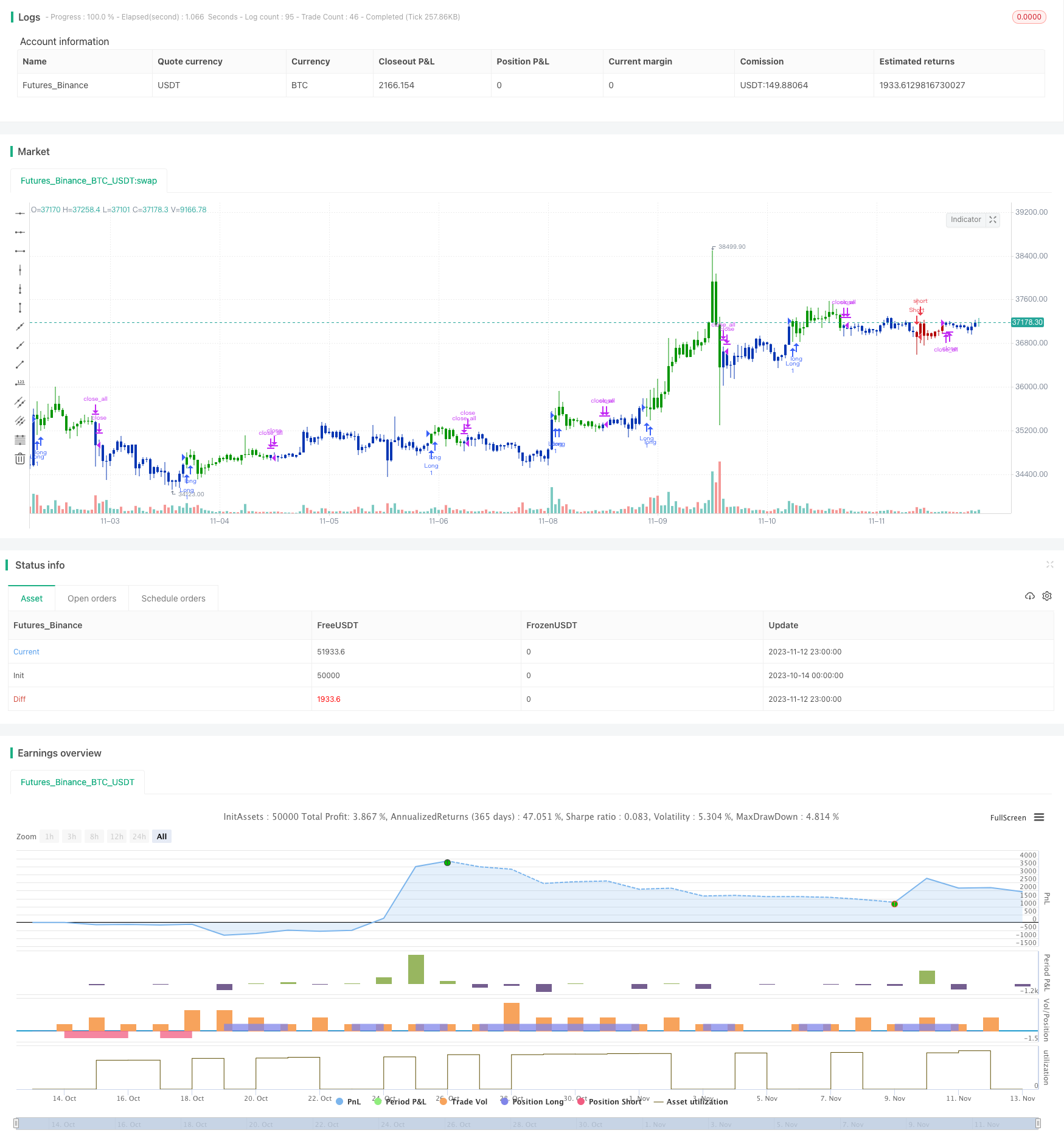Dual-confirmation Reversal Trading Strategy
Author: ChaoZhang, Date: 2023-11-14 13:42:47Tags:

Overview
The dual-confirmation reversal trading strategy combines the 123 reversal pattern with the Stochastic RSI indicator to create a robust mean-reversion system. It provides two layers of confirmation before entering a trade, improving the strategy’s accuracy and stability.
Strategy Logic
The strategy consists of two components:
- 123 Reversal
It uses the 123 pattern to identify potential reversals. The logic is:
-
Long if close < previous close and current close > previous close and 9-day Slow Stochastic < 50
-
Short if close > previous close and current close < previous close and 9-day Fast Stochastic > 50
This provides an early signal for price reversals.
- Stochastic RSI
It applies Stochastic indicator on RSI for additional confirmation:
-
Compute RSI with length 14
-
Calculate Stochastic of RSI, with lengths 14, to get K
-
Take 3-day SMA of K to get D
-
If K crosses above 80, it indicates long. If K crosses below 20, it indicates short.
A trade is triggered only when both parts agree.
Advantage Analysis
The key advantage of this strategy is the double confirmation, which improves accuracy and reduces whipsaws. Specific benefits include:
-
123 reversal provides early detection of trend reversal
-
Stochastic RSI confirms the reversal signal
-
Combination improves win rate and reduces false signals
-
Parameters can be optimized for different markets
-
Simple and clean implementation for live trading
Risk Analysis
Some risks to consider for this strategy:
-
Failed reversal risk. False reversals may cause losses.
-
Parameter optimization risk. Bad parameters lead to poor performance.
-
Overfitting risk. Excessive optimization to historical data.
-
High trading frequency risk. More signals may increase costs.
-
Coding error risk. Bugs in implementation logic.
Possible solutions:
-
Use prudent position sizing to limit losses.
-
Employ walk-forward optimization methods.
-
Focus on parameter stability, not high returns.
-
Tune conditions to reduce trade frequency.
-
Thoroughly test code logic.
Enhancement Opportunities
The strategy can be improved in the following areas:
-
Parameter tuning for specific markets.
-
Adding filters to avoid hasty reversals.
-
Incorporating stop loss mechanisms.
-
Reducing trade frequency with additional filters.
-
Implementing dynamic position sizing.
-
Adjusting for transaction costs.
Conclusion
The dual-confirmation reversal strategy is a stable and practical system for short-term mean-reversion. It balances the sensitivity to catch reversals and the accuracy from dual confirmation. With proper optimization and modifications, it can effectively complement a quantitative strategy portfolio. But parameters should be robust and risks like overfitting and whipsaws should be managed prudently in live trading.
/*backtest
start: 2023-10-14 00:00:00
end: 2023-11-13 00:00:00
period: 1h
basePeriod: 15m
exchanges: [{"eid":"Futures_Binance","currency":"BTC_USDT"}]
*/
//@version=4
////////////////////////////////////////////////////////////
// Copyright by HPotter v1.0 03/08/2021
// This is combo strategies for get a cumulative signal.
//
// First strategy
// This System was created from the Book "How I Tripled My Money In The
// Futures Market" by Ulf Jensen, Page 183. This is reverse type of strategies.
// The strategy buys at market, if close price is higher than the previous close
// during 2 days and the meaning of 9-days Stochastic Slow Oscillator is lower than 50.
// The strategy sells at market, if close price is lower than the previous close price
// during 2 days and the meaning of 9-days Stochastic Fast Oscillator is higher than 50.
//
// Second strategy
// This strategy used to calculate the Stochastic RSI
//
// WARNING:
// - For purpose educate only
// - This script to change bars colors.
////////////////////////////////////////////////////////////
Reversal123(Length, KSmoothing, DLength, Level) =>
vFast = sma(stoch(close, high, low, Length), KSmoothing)
vSlow = sma(vFast, DLength)
pos = 0.0
pos := iff(close[2] < close[1] and close > close[1] and vFast < vSlow and vFast > Level, 1,
iff(close[2] > close[1] and close < close[1] and vFast > vSlow and vFast < Level, -1, nz(pos[1], 0)))
pos
SRSI(lengthRSI,lengthStoch,smoothK,smoothD, TopBand,LowBand) =>
pos = 0.0
Source = close
rsi1 = rsi(Source, lengthRSI)
k = sma(stoch(rsi1, rsi1, rsi1, lengthStoch), smoothK)
d = sma(k, smoothD)
d_cross_80 = cross(d,TopBand)
pos := iff(k > TopBand, 1,
iff(k < LowBand, -1, nz(pos[1], 0)))
pos
strategy(title="Combo Backtest 123 Reversal & Stochastic RSI", shorttitle="Combo", overlay = true)
line1 = input(true, "---- 123 Reversal ----")
Length = input(14, minval=1)
KSmoothing = input(1, minval=1)
DLength = input(3, minval=1)
Level = input(50, minval=1)
//-------------------------
line2 = input(true, "---- Stochastic RSI ----")
TopBand = input(80, step=0.01)
LowBand = input(20, step=0.01)
lengthRSI = input(14, minval=1)
lengthStoch = input(14, minval=1)
smoothK = input(3, minval=1)
smoothD = input(3, minval=1)
reverse = input(false, title="Trade reverse")
posReversal123 = Reversal123(Length, KSmoothing, DLength, Level)
posSRSI = SRSI(lengthRSI,lengthStoch,smoothK,smoothD, TopBand,LowBand)
pos = iff(posReversal123 == 1 and posSRSI == 1 , 1,
iff(posReversal123 == -1 and posSRSI == -1, -1, 0))
possig = iff(reverse and pos == 1, -1,
iff(reverse and pos == -1 , 1, pos))
if (possig == 1 )
strategy.entry("Long", strategy.long)
if (possig == -1 )
strategy.entry("Short", strategy.short)
if (possig == 0)
strategy.close_all()
barcolor(possig == -1 ? #b50404: possig == 1 ? #079605 : #0536b3 )
- Trend Following Strategy Based on Moving Average and Super Trend
- Simple Moving Average Crossover Strategy
- Dual Take Profit Moving Average Crossover Quantitative Strategy
- RSI Oscillator Turtle Trading Short-term Strategy
- McGinley Moving Average Trading Strategy
- Quantitative Trading Strategy Based on Improved Vortex Indicator
- Multi Timeframe Trend Tracking Strategy
- Dual-track Oscillator Pattern Strategy
- Momentum Squeeze Strategy
- MCL-YG Bollinger Band Breakout Pair Trading Strategy
- Trend Reversal Tracking Stop Loss Strategy
- Weekend Trading Strategy
- ANN-based Quantitative Trading Strategy
- Momentum Breakout Strategy
- Dual MACD Quantitative Trading Strategy
- Corn Moving Average Balance Trading Strategy
- Dual Reversal Entry Strategy
- Momentum Market Sentiment Indicator Strategy
- Momentum Squeeze Breakout Trend Tracking Strategy
- Inverse MACD Momentum Entangled with DMI Breakout Short-Term Scalping Strategy